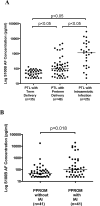The calcium binding protein, S100B, is increased in the amniotic fluid of women with intra-amniotic infection/inflammation and preterm labor with intact or ruptured membranes
- PMID: 17624933
- PMCID: PMC2587429
- DOI: 10.1515/JPM.2007.101
The calcium binding protein, S100B, is increased in the amniotic fluid of women with intra-amniotic infection/inflammation and preterm labor with intact or ruptured membranes
Abstract
Objective: S100B is produced by glia of the central and peripheral nervous systems and is considered a marker of neurologic injury in the perinatal period. Indeed, increased neonatal urine S100B concentration is associated with adverse neurological outcomes including intraventricular hemorrhage and hypoxic-ischemic encephalopathy, while elevated adult serum concentrations are associated with infectious diseases/sepsis. The objective of this study was to determine whether amniotic fluid (AF) S100B concentrations change with advancing gestational age and intra-amniotic infection (IAI).
Study design: S100B concentration was measured in the AF of women in midtrimester, at term, and in pregnancies with preterm labor and intact membranes (PTL) or preterm premature rupture of membranes (PPROM), with and without IAI. Placental pathology was performed and neonatal outcomes were analyzed.
Results: (1) AF S100B concentration did not change during gestation; (2) patients with IAI had significantly higher AF S100B concentration than those without IAI following an episode of PTL or PPROM and; (3) neonates who had morbidity/mortality had had an elevated AF S100B concentration; however, this could be explained by the association with intra-amniotic infection/inflammation. Thus, AF S100B concentration was not an independent predictor of neonatal morbidity or fetal/neonatal death.
Conclusions: An elevated concentration of AF S100B may reflect intra-amniotic infection/inflammation and not necessarily fetal neurologic damage.
Figures


Similar articles
-
Damage-associated molecular patterns (DAMPs) in preterm labor with intact membranes and preterm PROM: a study of the alarmin HMGB1.J Matern Fetal Neonatal Med. 2011 Dec;24(12):1444-55. doi: 10.3109/14767058.2011.591460. Epub 2011 Sep 29. J Matern Fetal Neonatal Med. 2011. PMID: 21958433 Free PMC article.
-
Amniotic fluid fetal hemoglobin in normal pregnancies and pregnancies complicated with preterm labor or prelabor rupture of membranes.J Matern Fetal Neonatal Med. 2009 May;22(5):388-97. doi: 10.1080/14767050802578285. J Matern Fetal Neonatal Med. 2009. PMID: 19529995 Free PMC article.
-
Resistin in amniotic fluid and its association with intra-amniotic infection and inflammation.J Matern Fetal Neonatal Med. 2008 Dec;21(12):902-16. doi: 10.1080/14767050802320357. J Matern Fetal Neonatal Med. 2008. PMID: 19065463 Free PMC article.
-
Fragment Bb in amniotic fluid: evidence for complement activation by the alternative pathway in women with intra-amniotic infection/inflammation.J Matern Fetal Neonatal Med. 2009 Oct;22(10):905-16. doi: 10.1080/14767050902994663. J Matern Fetal Neonatal Med. 2009. PMID: 19603351 Free PMC article.
-
Proteomics, part II: the emerging role of proteomics over genomics in spontaneous preterm labor/birth.Obstet Gynecol Surv. 2006 Aug;61(8):543-53. doi: 10.1097/01.ogx.0000228779.39568.59. Obstet Gynecol Surv. 2006. PMID: 16842635 Review.
Cited by
-
Amnion epithelial cell-derived exosomes induce inflammatory changes in uterine cells.Am J Obstet Gynecol. 2018 Nov;219(5):478.e1-478.e21. doi: 10.1016/j.ajog.2018.08.021. Epub 2018 Aug 21. Am J Obstet Gynecol. 2018. PMID: 30138617 Free PMC article.
-
Damage-associated molecular patterns (DAMPs) in preterm labor with intact membranes and preterm PROM: a study of the alarmin HMGB1.J Matern Fetal Neonatal Med. 2011 Dec;24(12):1444-55. doi: 10.3109/14767058.2011.591460. Epub 2011 Sep 29. J Matern Fetal Neonatal Med. 2011. PMID: 21958433 Free PMC article.
-
Inflammasome activation during spontaneous preterm labor with intra-amniotic infection or sterile intra-amniotic inflammation.Am J Reprod Immunol. 2018 Nov;80(5):e13049. doi: 10.1111/aji.13049. Epub 2018 Sep 18. Am J Reprod Immunol. 2018. PMID: 30225853 Free PMC article.
-
Patients with acute cervical insufficiency without intra-amniotic infection/inflammation treated with cerclage have a good prognosis.J Perinat Med. 2019 Jul 26;47(5):500-509. doi: 10.1515/jpm-2018-0388. J Perinat Med. 2019. PMID: 30849048 Free PMC article.
-
The predictive value of hemogram parameters for early preterm delivery in pregnant women undergoing cervical cerclage.Rev Assoc Med Bras (1992). 2024 Aug 16;70(7):e20240030. doi: 10.1590/1806-9282.20240030. eCollection 2024. Rev Assoc Med Bras (1992). 2024. PMID: 39166662 Free PMC article.
References
-
- Anderson RE, Hansson LO, Nilsson O, jlai-Merzoug R, Settergren G. High serum S100B levels for trauma patients without head injuries. Neurosurgery. 2001;48:1255–1258. - PubMed
-
- Becker T, Gerke V, Kube E, Weber K. S100P, a novel Ca(2+)-binding protein from human placenta. cDNA cloning, recombinant protein expression and Ca2+ binding properties. Eur J Biochem. 1992 Jul 15;207:541–547. 1992. - PubMed
-
- Bertsch T, Casarin W, Kretschmar M, Zimmer W, Walter S, Sommer C, et al. Protein S-100B: a serum marker for ischemic and infectious injury of cerebral tissue. Clin Chem Lab Med. 2001;39:319–323. - PubMed
-
- Florio P, Marinoni E, Di IR, Bashir M, Ciotti S, Sacchi R, et al. Urinary S100B protein concentrations are increased in intrauterine growth-retarded newborns. Pediatrics. 2006;118:e747–e754. - PubMed
-
- Florio P, Michetti F, Bruschettini M, Lituania M, Bruschettini P, Severi FM, et al. Amniotic fluid S100B protein in mid-gestation and intrauterine fetal death. Lancet. 2004;364:270–272. - PubMed
Publication types
MeSH terms
Substances
Grants and funding
LinkOut - more resources
Full Text Sources
Other Literature Sources
Medical
Miscellaneous
